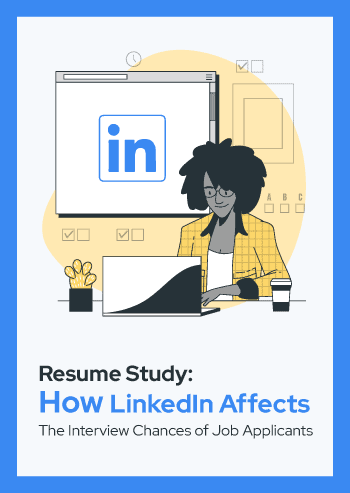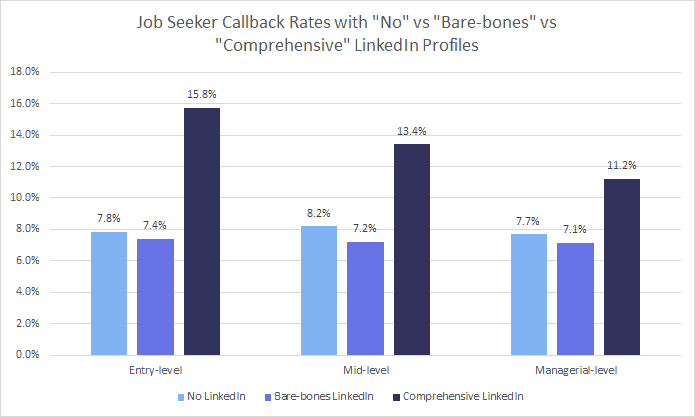Resume Study: How LinkedIn affects the Interview Chances of Job Applicants
Job seekers with a comprehensive LinkedIn profile have a 71% higher chance of getting a job interview

Job seekers with a comprehensive LinkedIn profile have a 71% higher chance of getting a job interview
As the largest professional network in the world with over 500 million unique users, LinkedIn offers a plethora of benefits to job seekers looking to advance their careers and find a new job. These benefits include allowing job seekers to connect with recruiters, establish their personal brand, and cultivate a business network that will ultimately advance their careers. As with sites like Indeed and ZipRecruiter, LinkedIn can also be used as an online employment website where job seekers can find and apply to various job openings posted by employers. While the potential upsides of using LinkedIn are irrefutable, many job seekers still opt not to incorporate LinkedIn into their job search strategy. Methods such as attending job fairs, finding jobs through traditional job boards and career websites, using recruitment agencies, and other methods are used instead. However, even in such cases, LinkedIn plays a pivotal role in the recruitment process. Many recruiters will still be interested in going through a job seeker’s LinkedIn profile as part of their standard applicant review process in order to learn more about the applicant’s professional experience. This is what has led ResumeGo, a resume writing service, to question, “How does having a LinkedIn profile and including it on a job seeker’s resume actually affect callback rates when it comes to applying to job openings online?” To find the answer to this, ResumeGo conducted a field experiment from October 9, 2018 to March 8, 2019 where 24,570 fictitious resumes were submitted to job openings found on various job search websites such as Indeed, ZipRecruiter, and Glassdoor. A third of these resumes did not contain a link to the applicant’s LinkedIn profile, another third of these resumes included a link to the applicant’s “bare-bones” LinkedIn profile, and the remaining third of these resumes included a link to the applicant’s “comprehensive” LinkedIn profile. The callback rates for these three distinct types of submissions were recorded in order to determine the impact of not having a LinkedIn profile at all versus having a bare-bones LinkedIn profile versus having a comprehensive LinkedIn profile. The distinction between a “bare-bones” vs “comprehensive” LinkedIn profile is made in the study in order to determine how important it is to employers that applicants spend the time to build connections on LinkedIn and provide extensive detail of their work history, as opposed to simply throwing together a LinkedIn profile that provides basic information but lacks the same level of time and effort put into it.Only comprehensive LinkedIn profiles improved the interview chances of job applicants
Based on the results of the field experiment, job applicants who included a link to a comprehensive LinkedIn profile on their resumes received a callback rate of 13.5%, which is 71% higher than the 7.9% callback rate of job applicants who didn’t have a LinkedIn profile at all. On the other hand, having an bare-bones LinkedIn profile did not increase the callback rate for job applicants. In fact, applicants who included a link to a bare-bones LinkedIn profile on their resumes only received a callback rate of 7.2%, which is slightly lower than the callback rate for applicants with no LinkedIn profile listed on their resume at all.As job level increased, the importance of including a LinkedIn profile decreased slightly
The study categorized each job opening as either an entry-level, mid-level, or managerial-level position in order to assess the relationship between job level and employer emphasis on LinkedIn. The title of the job position, years of experience required, salary level, and job duties were all considered in determining the level of each job opening. The findings showed that as job level increased, the gap in callback rates decreased between job applicants with a comprehensive LinkedIn profile and job applicants with no LinkedIn profile at all. This suggests that employers may care more about LinkedIn when evaluating job seekers in lower-level job positions compared to higher-level job positions. The callback rates we received are broken down in the chart below:
Experimental Design
A total of 24,570 job openings were applied to. In order to measure the impact of not having a LinkedIn profile at all versus having a bare-bones LinkedIn profile versus having a comprehensive LinkedIn profile on a job seeker’s callback rate, submissions were broken down evenly into three groups of job applicants: Group 1: This group of job applicants did not use LinkedIn. These applicants shared the common trait of having no private nor public LinkedIn profile to their name that employers could associate with. Group 2: This group of job applicants all had a bare-bones LinkedIn profile. These applicants shared the common trait of having a public LinkedIn profile that was missing distinct elements to it. They represented the common group of job seekers who have created a LinkedIn profile with some basic information provided, but have yet to utilize all of its features or complete their profile. Bare-bones LinkedIn profiles had a profile summary of under 500 characters, 5 connections or less, no descriptions filled out for any of the work experiences listed, and no profile picture. Group 3: This group of job applicants all had comprehensive LinkedIn profiles. These applicants shared the common trait of having a public LinkedIn profile fully completed, and were meant to represent the job seekers who have taken considerable time to create a professional LinkedIn profile meant to impress employers. Unlike bare-bones LinkedIn profiles, comprehensive LinkedIn profiles had profile summaries of over 1000 characters, 300 connections or more, dense bullet-point or paragraph-based descriptions for every work experience section listed, and a professional headshot. Each group of job applicants applied to 8,190 job openings that were found on job search sites such as Indeed, ZipRecruiter, and Glassdoor. To cover a wide range of industries, the jobs applied to varied in nature, and included, but were not limited to, jobs in finance, marketing, accounting, human resources, technology, science, engineering, education, retail, and healthcare. The resumes used to apply to these job openings were fictitious, but realistic, and based on actual job seekers. Job applicants in Group 1 submitted resumes that did not include any mention of LinkedIn at all, whereas job applicants in Group 2 and Group 3 submitted resumes that included a hyperlink to their LinkedIn profile at the top of their resume. In order to ensure that any differences in callback rates observed stemmed as a result of the independent variable in question and not from the varying quality of the resumes used, each resume was submitted the same number of times for an applicant in each group, only with the alias and LinkedIn profile of the applicant changed.Final Thoughts
The findings of this study suggest that job seekers who invest their time into creating a professional LinkedIn profile have a considerable advantage over job seekers who don’t. However, if employers see that little time and effort were put into creating the LinkedIn profile, there is no benefit in having one. In fact, there may be slightly adverse effects on the job seeker’s chances of being given an interview in such a scenario. One potential explanation for this is that employers may associate, either consciously or subconsciously, bare-bones LinkedIn profiles with low-quality work. They’d rather see no LinkedIn profile at all than see one that lacks any effort put into it. This is, of course, just conjecture, and more research and professional input would be required before drawing any strong conclusions. While having a LinkedIn profile is almost never mandated by employers, having one can prove to be beneficial to job seekers. Furthermore, job seekers who use methods of finding employment that do not involve LinkedIn at all should realize that having a strong LinkedIn profile may still be important to employers.71% higher
interview callback rate9% decrease
in interview callback rateincreased
the impact of LinkedIndecreased
Are you a hiring professional? Share your expertise!
More surveys are to come and the more insight the better. We’re welcoming recruiters and hiring professionals to shed light on their hiring habits and preferences.


See other resume research we’ve done.
Data is used for everything, so why not for resume writing? See more surveys and field experiments we’ve conducted over the years that have influenced the way resumes and other job documents are written.
More resources for your resume and job search
Whether you’re a career expert or a total beginner, there’s always more to learn. Use these resources to level up your resume and build your career.


